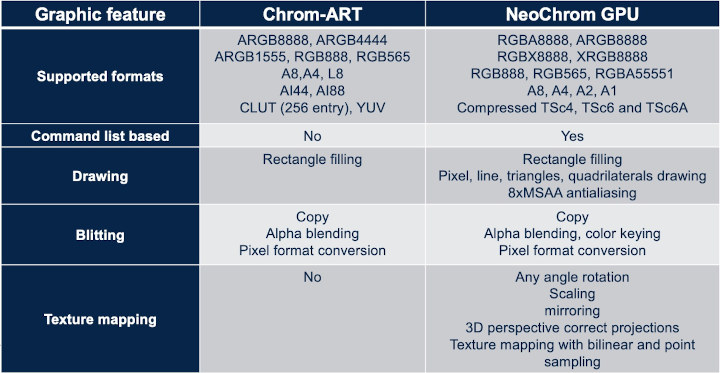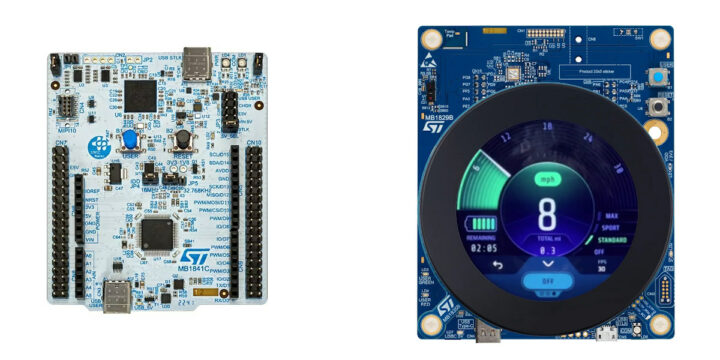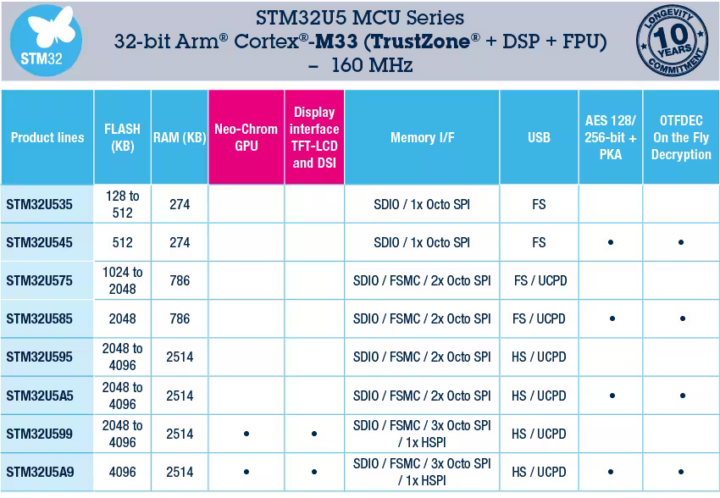STMicro has added three new families to its STM32U5 Cortex-M33 microcontroller series with the entry-level STM32U535/545 with as little as 128KB flash, the STM32U595/5A5 with up to 4MB of Flash and 2,514KB of RAM, and the STM32U599/5A9 with similar features as the STM32U595/5A5 by adding the new NeoChrom 2.5D GPU plus TFT-LCD and DSI display interfaces.
STMicro also announced that STM32U5 series MCUs were the first general-purpose MCUs to receive NIST-embedded random-number entropy source certification. As of now, along with the STM32U575/585 introduced in February 2021 with an optional Chrom-ART 2D GPU, STMicro offers eight product lines as part of the STM32U5 MCU series as shown in the table below.
That means the STM32U5 microcontroller can address a wider range of applications with the STM32U535/545 targetting lower-cost applications with less flash and RAM, the “legacy” STM32U575/U585 for mid-range applications, and the STM32U59X/5AX for applications where more storage and memory is required, and the parts with graphics support can be integrated into HMI applications. STMicro specifically says the new MCUs can be used in “deeply embedded” applications such as environmental sensors, industrial actuators, building automation, smart appliances, wearable devices, eMobility controls, and others.
Besides relying on a Cortex-M33 with Arm Trustzone architecture, some of the STM32U5 integrate cryptographic accelerators for up to 256-bit AES algorithms, support public key architecture (PKA), and on-the-fly flash decryption. STMicro also claims the STM32U5 is the first general-purpose group of MCUs to receive the NIST (US National Institute of Standards and Technology) embedded random-number entropy source certification, and since the certification is reusable by customers, it should speed up the development of SP800-90B-certified products.

The new STM32U5 microcontroller parts have many of the same features as the first STM32U5, except for variations in terms of memory and storage capacity, and the number of interfaces. But one really new feature from the latest STM32U5 announcement is the NeoChrom GPU which can enable more advanced when compared to the Chrom-ART 2D GPU used in the earlier parts. STMicro goes on to say the STM32U5 embedded processor can host smartphone-like GUIs that leverage ST’s TouchGFX framework with support for SVG and rich graphical assets.
The video below showcases demos running on the Arm-Cortex-M33 MCU core and then on the NeoChrom GPU (in STM32U599) to show the difference in terms of FPS.
Software development can be done with the STM32Cube and STM32Cube.AI development ecosystem with the latter enabling the creation of AI/ML solutions through the conversion of pre-trained neural networks into optimized code. The NUCLEO-U545RE and NUCLEO-U5A5ZJ development boards, and the STM32U5A9J-DK Discovery kit can be used for evaluation and development.

The new STM32U5 devices will enter mass production in Q2 2023 with pricing starting at $2.15 for orders of 10,000 pieces. The development kits don’t seem to be in stock at this time, and you’re asked to contact your sales representative. More details may be found on the product page.

Jean-Luc started CNX Software in 2010 as a part-time endeavor, before quitting his job as a software engineering manager, and starting to write daily news, and reviews full time later in 2011.
Support CNX Software! Donate via cryptocurrencies, become a Patron on Patreon, or purchase goods on Amazon or Aliexpress






It should be noticed that the STM32U595, U599, UA5 and UA9 families come with an integrated HS USB PHY. This is something that was lacking on ST MCU (except for some STM32F723), let’s hope that it will also arrive to other series.